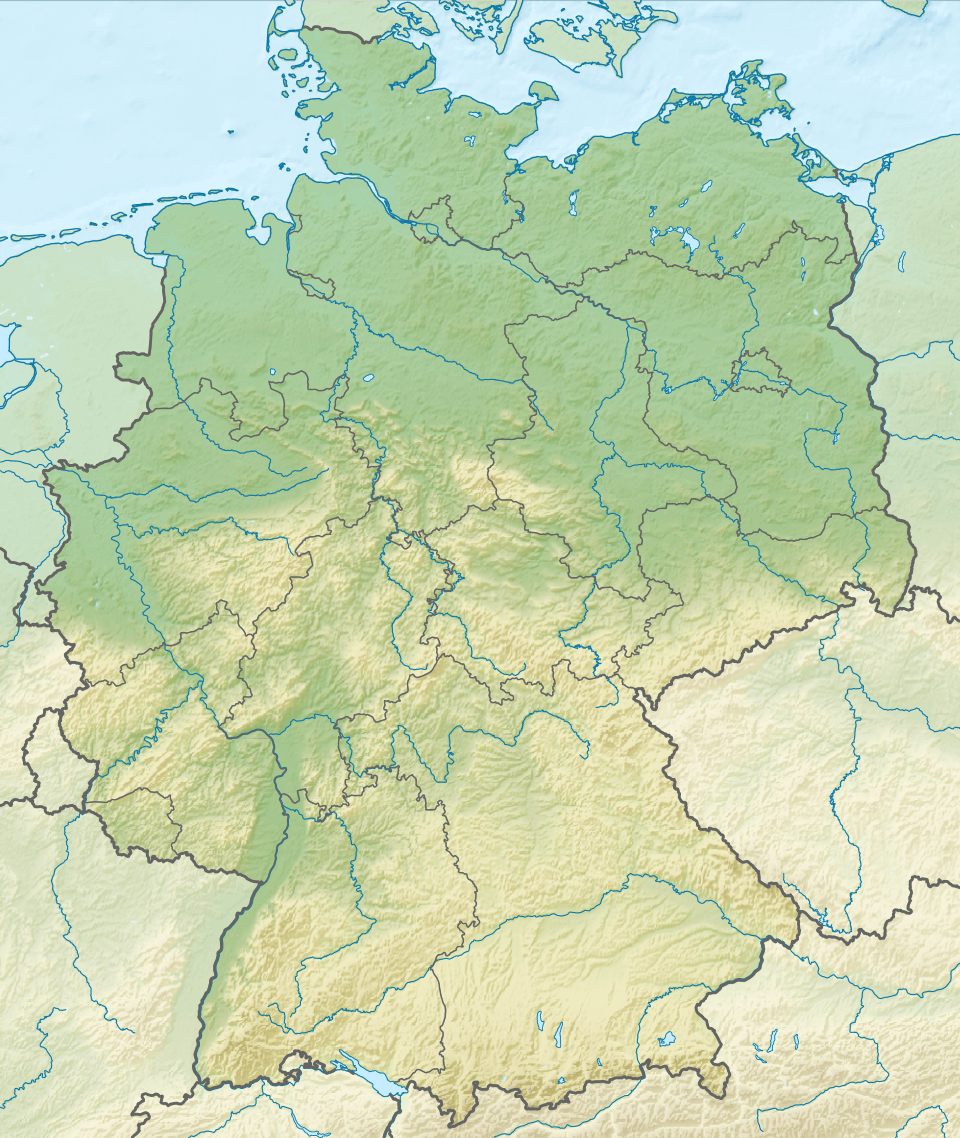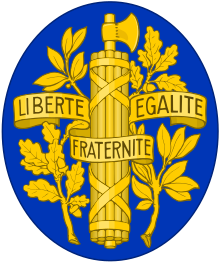Sigmaringen enclave
The Sigmaringen enclave was the exiled remnant of France's Nazi-sympathizing Vichy government which had to flee to Germany during the Liberation of France near the end of World War II in order to avoid capture by the advancing Allied Powers of World War II. They were allocated the requisitioned Sigmaringen Castle as the seat of their government-in-exile.
| French Governmental Commission for the Defense of National Interests[lower-alpha 1] | |
|---|---|
| Date formed | 6 September 1944 |
| Date dissolved | 22 April 1945 |
| People and organisations | |
| Deputy head of government | Fernand de Brinon |
| Status in legislature | none |
| History | |
| Incoming formation | enforced evacuation of Vichy by German forces |
| Outgoing formation | advancing Allied forces |
| Predecessor | Second Laval administration (1942-1944) |
| Successor | none |



The puppet government occupied the castle for seven months with nothing to govern, Pétain keeping to himself, while the others wined and dined on unlimited food and drink, and local residents faced wartime rationing.
History
Background
Nazi Germany invaded France in May 1940 during the early part of World War II. The Armistice of 22 June 1940 ended hostilities, dividing France into two zones: an Occupied zone in the north and west, and a nominally "free zone" (Zone libre) in the south and east. Known officially as the "French State", the Zone libre became known as the "Vichy regime" for the location of its nominal capital. The regime was headed by Marshall Philippe Pétain, who was given full powers to control the regime. In November 1942, the Zone libre was also occupied by the Germans, in response to the landing of the Allies in North Africa. Vichy lost its military force, but continued to exercise jurisdiction over most of Metropolitan France until the gradual collapse of the Vichy regime following the Allied invasion in June 1944 and the ongoing liberation of France.
Transition
On 17 August 1944, Vichy's head of government and minister of foreign affairs Pierre Laval held the last government council of with five of is government ministers.[1] With permission from the Germans, he attempted to call back the prior National Assembly with the goal of giving it power[2] and thus impeding the communists and de Gaulle.[3] So he obtained the agreement of German ambassador Otto Abetz to bring Édouard Herriot, (President of the Chamber of Deputies) back to Paris.[3] But ultra-collaborationists Marcel Déat and Fernand de Brinon protested this to the Germans, who changed their minds[4] and took Laval to Belfort[5] along with the remains of his government, "to assure its legitimate security", and arrested Herriot.[6]
Also on 17 August, Cecil von Renthe-Fink, "special diplomatic delegate of the Führer to the French Head of State", asked Pétain to allow himself to be transferred to the northern zone.[7] Pétain refused and asked for a written formulation of this request.[7] Von Renthe-Fink renewed his request twice on the 18th, then returned on the 19th, at 11:30, accompanied by General von Neubroon, who told him that he had "formal orders from Berlin".[7] The written text is submitted to Pétain: "The Reich Government instructs that the transfer of the Head of State be carried out, even against his will".[7] Faced with the Marshal's continued refusal, the Germans threatened to bring in the Wehrmacht to bomb Vichy.[7] After having requested the Swiss ambassador Walter Stucki to bear witness to the Germans' blackmail, Pétain submitted. When Renthe-Fink entered the Marshal's office at the Hôtel du Parc with General von Neubronn "at 7:30 p.m.", the Head of State was supervising the packing up of his suitcases and papers.[7] The next day, 20 August 1944, Pétain was taken against his will by the German army to Belfort and then, on 8 September to Sigmaringen in southwestern Germany,[8] where dignitaries of his regime had taken refuge. Rather than resigning, he maintained in a letter to the French the fiction that "I am, and remain morally, your leader".
Formation
Hitler requisitioned the Sigmaringen Castle belonging to the Hohenzollerns in the town of Sigmaringen in Swabia, southwestern Germany. This was then occupied and used by the Vichy government-in-exile from September 1944 to April 1945. Vichy head of state Marshal Philippe Pétain was brought there against his will, and refused to cooperate,[9] and ex-Prime Minster Pierre Laval also refused.[10] Despite the efforts of the collaborationists and the Germans, Pétain never recognized the Sigmaringen Commission.[11] The Germans, wanting to present a facade of legality, enlisted other Vichy officials such as Fernand de Brinon as president, along with Joseph Darnand, Jean Luchaire, Eugène Bridoux, and Marcel Déat.[12]
On 7 September 1944[13], fleeing the advance of Allied troops into France, while Germany was in flames and the Vichy regime ceased to exist, a thousand French collaborators (including a hundred officials of the Vichy regime, a few hundred members of the French Militia, collaborationist party militants, and the editorial staff of the newspaper Je suis partout) but also waiting-game opportunists[lower-alpha 2] also went into exile in Sigmaringen.
Militia leaders sought to recruit new members to swell the ranks of the Franc-Garde by finding sympathizers, especially in the enforced labor camps of prisoners in Germany. Their goal was to promote the ideal of a true National Revolution by actively preparing for an underground struggle by creating Maquis groups. Operation Maquis blanc was designed to parachute in political agitators, who, when the time came, would sow panic and prepare future agents who would be able to infiltrate French society more easily than German agents could.
Legal status
The Castle received official designation from Germany as extraterritorialized to France and became a French enclave legally, complete with flag-raising.[14] It was a matter of some importance to attempt to gain legal recognition for the government in exile from other countries, however at Sigmaringen, there were only the embassies of Germany and of Japan[15] and an Italian consulate which maintained a presence. The governmental commission was thus a legal, French enclave from September 1944 through April 1945.[16]
Commission
The offices used the official title French Delegation (Délégation française) or the French Government Commission for the Defense of National Interests.[lower-alpha 1]
The commission had its own radio station (Radio-patrie, Ici la France) and official press (La France, Le Petit Parisien), and hosted the embassies of the Axis powers: Germany, Italy and Japan. The population of the enclave was about 6,000, including known collaborationist journalists, the writers Louis-Ferdinand Céline and Lucien Rebatet, the actor Robert Le Vigan, and their families, as well as 500 soldiers, 700 French SS, prisoners of war and French civilian forced laborers.[17]
Daily life
Pétain and his ministers, although "on strike"[9] were lodged in the requisitioned Sigmaringen castle of the Hohenzollerns. Pétain chose a suite that wasn't too big, as it was less cold. The rest of the enclave was lodged in schools and gymnasiums converted to dormitories, or in scarce rooms in private residences or in hotels such as the Bären or the Löwen[18] which were mostly reserved for more distinguished guests, notably the author Louis-Ferdinand Céline, who later wrote about his experience in his book Castle to Castle.[19]. In his book, Céline speaks at length about the Löwen Brasserie where the French gathered to follow the news of the approaching Allied armies and to talk about the latest rumors about the imminent, albeit improbable, German victory in the war.[13]
New arrivals lived with difficulty in the cramped dwellings of the city under the rumblings of American bombs in the summer, but it was worse during the intensely cold winter that reached -30 °C in December 1944.[lower-alpha 3] Inadequate housing, insufficient food, promiscuity among the paramilitaries, and lack of hygiene facilitated the spread of numerous illnesses including flu and tuberculosis) and a high mortality rate among children, ailments that were treated as best they could by the only two French doctors, Doctor Destouches, alias Louis-Ferdinand Céline and Bernard Ménétrel.[13]
Dissolution
On 21 April 1945 General de Lattre ordered his forces to take Sigmaringen. The end came within days. By the 26th, Pétain was in the hands of French authorities in Switzerland,[20] and Laval had fled to Spain.[10] Brinon,[21] Luchaire, and Darnand were captured, tried, and executed by 1947. Other members escaped to Italy or Spain.
Exilees
Exilees included the unwilling Pétain and Laval, the Commission members, as well as several thousand other collaborators or those sympathetic to the Nazis. Some prominent residents of the enclave include:
Filmography
Several documentaries or fictionalized documentaries have been released about the Sigmaringen enclave. These include:
- Sigmaringen, l'ultime trahison [Sigmaringen, the ultimate betrayal] – a documentary by Rachel Kahn and Laurent Perrin, 1996, 56 min. (VHS)[22].
- The darkness - terminus Sigmaringen [Die Finsternis, Germany, 2005] – a documentary by Thomas Tielsch, after the novel by Louis-Ferdinand Céline, K-Films, 2006, 82 min. (DVD).
- Sigmaringen, the last refuge – documentary-fiction by Serge Moati, Arte France, 2015, 78 min.
See also
- Collaboration with the Axis Powers during World War II
- Épuration légale
- Foreign relations of Vichy France
- France–Germany border
- Free France
- French prisoners of war in World War II
- French Resistance
- German occupation of France
- Italian occupation of France during World War II
- Liberation of France
- Liberation of Paris
- Military history of France during World War II
- Operation Dragoon
- Provisional Government of the French Republic
- Pursuit of Nazi collaborators
- Zone libre
References
- Notes
- Commission gouvernementale française pour la défense des intérêts nationaux; also known as the Délégation gouvernementale française pour la défense des intérêts français en Allemagne
- "waiting-game opportunists": Attentistes in the original.
- Having left France in a panic ahead of advancing Allied forces, they arrived exclusively with summer clothing, and suffered from the cold.
- Footnotes
- Brissaud 1965, p. 504-505.
- Paxton-fr 1997, p. 382-383.
- Kupferman 2006, p. 520–525.
- Brissaud 1965, p. 491-492.
- Jäckel-fr 1968, p. 495.
- Kupferman 2006, p. 527–529.
- Aron 1962, p. 41-42.
- Aron 1962, p. 41-45.
- Aron 1962, p. 40,45.
- Aron 1962, p. 81–82.
- Sautermeister, 2013 & 13.
- Rousso 1999, p. 51–59.
- Béglé 2014.
- Lottman 1985, p. 349.
- Joseph 2002, p. 521.
- Sautermeister 2013, p. 15.
- Jackson 2001, p. 567–568.
- Schneider 2007.
- Brissaud 1966, p. 207.
- Aron 1962, p. 48–49.
- Cointet 2014, p. 426.
- Peyret, Emmanuèle (9 March 1996). "Samedi, France 3, 22 h 30. Les dossiers de l'histoire : « Sigmaringen, l'ultime trahison », documentaire. Voyage au bout de la collaboration. L'agonie de « L'État français » pétainiste dans une forteresse allemande" [Saturday, France 3, 10:30 p.m. Topics in History: 'Sigmaringen, the ultimate betrayal', documentary. Journey to the depths of collaboration. The death throes of the petainist 'French State' inside a German fortress.]. liberation.fr. Libération. Retrieved 15 August 2020..
Works cited
- Aron, Robert (1962). "Pétain : sa carrière, son procès" [Pétain: his career, his trial]. Grands dossiers de l'histoire contemporaine [Major issues in contemporary history] (in French). Paris: Librairie Académique Perrin. OCLC 1356008.
- Béglé, Jérôme (20 January 2014). "Rentrée littéraire - Avec Pierre Assouline, Sigmaringen, c'est la vie de château !" [Autumn publishing season launch - With Pierre Assouline, Sigmaringen, That's life in the castle]. Le Point (in French). Le Point Communications.
- Brissaud, André (1965), La Dernière année de Vichy (1943-1944) [The Last Year of Vichy] (in French), Paris: Librairie Académique Perrin, OCLC 406974043
- Cointet, Jean-Paul (2014). Sigmaringen. Tempus (in French). Paris: Perrin. ISBN 978-2-262-03300-2.
- Jäckel, Eberhard (1968) [1st pub. 1966: Deutsche Verlag-Anstalg GmbH (in German) as "Frankreich in Hitlers Europa – Die deutsche Frankreichpolitik im Zweiten Weltkrieg"]. La France dans l'Europe de Hitler [France in Hitler's Europe - Germany's France foreign policy in the Second World War]. Les grandes études contemporaines (in French). Paris: Fayard.
- Jackson, Julian (2001). France: The Dark Years, 1940–1944. Oxford University Press. ISBN 978-0-19-820706-1.
- Joseph, Gilbert (2002). Fernand de Brinon, l'aristocrate de la collaboration. Paris: Albin Michel. ISBN 978-2-226-11695-6. OCLC 1140347692. Retrieved 13 August 2020.
It was essential to confer upon the governmental Commission an insitutional foundation recognized by some countries. However, at Sigmaringen, only the embassies of Germany and of Japan maintained a presence.
CS1 maint: ref=harv (link)
- Kupferman, Fred (2006) [1st pub: Balland (1987)]. Laval (in French) (2 ed.). Paris: Tallandier. ISBN 978-2-84734-254-3.
- Lottman, Herbert R. (1985). Pétain, Hero Or Traitor: The Untold Story. New York: W. Morrow. ISBN 978-0-688-03756-7. OCLC 11840938. Retrieved 13 August 2020.
The Germans granted the commission extraterritoriality , this to be marked by the flag - raising already mentioned.
- Paxton, Robert O. (1997) [1st pub: 1972: Knopf (in English) as "Vichy France: old guard and new order, 1940-1944" (978-0394-47360-4)], La France de Vichy – 1940-1944, Points-Histoire (in French), translated by Bertrand, Claude, Paris: Éditions du Seuil, ISBN 978-2-02-039210-5
- Rousso, Henry (1999). Pétain et la fin de la collaboration : Sigmaringen, 1944-1945 [Pétain and the end of collaboration: Sigmaringen, 1944-1945] (in French). Paris: Éditions Complexe. ISBN 2-87027-138-7.
- Sautermeister, Christine (6 February 2013). Louis-Ferdinand Céline à Sigmaringen : réalité et fiction dans "D'un château l'autre. Ecriture. ISBN 978-2-35905-098-1. OCLC 944523109. Retrieved 13 August 2020.
De septembre 1944 jusque fin avril 1945, Sigmaringen constitue donc une enclave française. Le drapeau français est hissé devant le château. Deux ambassades et un consulat en cautionnent la légitimité : l'Allemagne, le Japon et l'Italie.
CS1 maint: ref=harv (link)
- Schneider, Rolf (4 September 2007). "Das ganze Schloss ein Blendwerk - Vichy in Sigmaringen" [The Entire Castle an Illusion - Vichy in Sigmaringen] (radio broadcast transript) (in German). Deutschlandfunk. Retrieved 14 August 2020.</ref>

.svg.png)